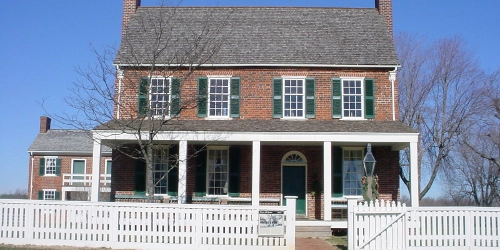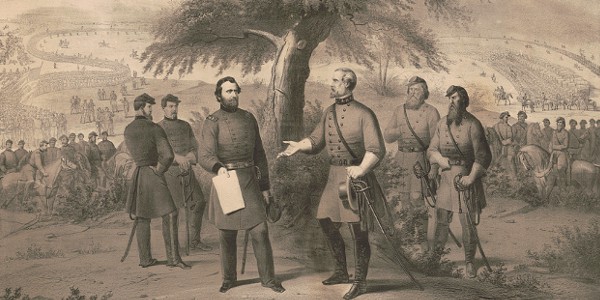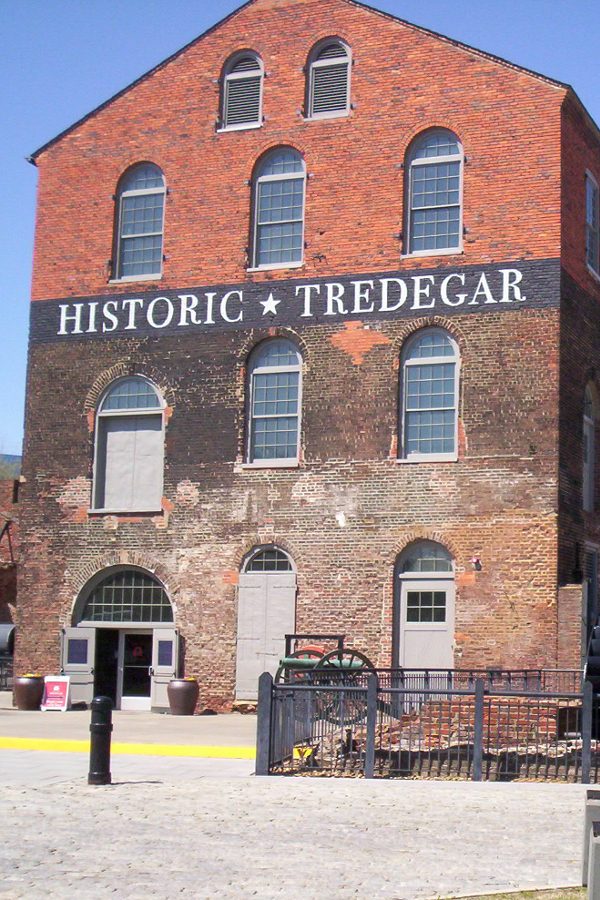
Photo above, the house of Wilmer McLean in 1865. This is the site chosen by General Lee for the surrender meeting in Appomattox Court House. Courtesy Library of Congress. Right: Clover Hill Tavern, Appomattox, Photo courtesy NPS.

Appomattox
This was the site of the culmination of four long, hard, and desperate years that saw the end of 720,000 soldiers on fields stretching from Pennsylvania to the western states, and in Appomattox Court House, a small town west of the sieges that had taken place over the last nine and one half months outside Petersburg and Richmond, Robert E. Lee's Confederate forces would surrender to General Grant in the McLean House in that town. A visit here puts a coda on those years. It adds a period to the sentence, actually a very long book, of stories of battle, of stories of people, of an arduous struggle to uphold states rights, end slavery, and bind a nation together that could have just as easily gone away.
Click here to Sponsor the page and how to reserve your ad.

Appomattox Then
We've stated this before, but if you don't think the Civil War has an impact on your life today, imagine pulling out your passport every time you traveled to Virginia, to Tennessee, to Missouri, any time you crossed a state line on the Mason-Dixon axis from Union to Confederate territory. That is the impact it would have on your life. You probably would not live in the most prosperous nation on earth. You would live in some version of Germany or France or the United Kingdom. It was the effort of the men and women of this 1861-1865 timeframe that gave you this type of nation and life; Appomattox Court House was the chapter that wrapped that effort up. And it wrapped it up in as remarkable a fashion as the arduous nature of those battles from Manassas to Gettysburg to Petersburg had shown in a very different way. That story is well worth a visit.
General Robert E. Lee had had enough by the night of April 2, 1865, trying to hold on in the trenches of Petersburg against a relentless foe in General U.S. Grant. When the final breakthrough of Union forces occurred that day, there was no choice but to flee Petersburg and Richmond and try to regroup. But U.S. Grant would follow, and one week later, that effort would culminate in a surrender in Appomattox Court House. And it was surrender of grace and not capture. That has to be underscored. There were no prisoners or repurcussions to the Southern soldiers, and even though reconstruction would be difficult and painful over the next ten years, the grace of the terms of surrender that Grant and Lincoln showed General Lee would eventually bind the nation together. And that's just plain remarkable. There have been two particularly remarkable moments in United States history that we often forget; Washington giving up the power of the presidency after his term of office (this had not been done before) and Lincoln's grace at the time he accepted Lee's surrender on the steps and in the living room of the McLean House in Appomattox Court House, Virginia.
Appomattox Station - Appomattox Station was the spot on a rail line (photo below) where General Lee sent rations and supplies to collect as he tried to retreat from Richmond and head south to North Carolina. However, General Custer had a different plan, capturing several of those railroad cars and starting a battle one mile from the station.
Appomattox Court House - This town, several miles further away, was a bucolic little berg of one hundred citizens that had never seen war during the four years of civil conflict. In fact, the McLean family had moved here from their home in Manassas after the first battle of Bull Run. Now it would come again and their home the unlikely location for the surrender meeting between Grant and Lee.
Image above: Lithograph of General Lee and General Grant at 2nd meeting about surrender, April 10, 1865, at tree on north end of town, by John Smith, circa 1865. Courtesy Library of Congress. Below: Confederate cavalry waiting to charge during the April 9 Battle of Appomattox Court House reenactment on the grounds of the park.

Minute Walk in History
Appomattox 160th Anniversary, Day One
On the 160th Anniversary of the last days of the Civil War at Appomattox, listen to park rangers and take a walk around the historic surrender site, and site of the two last battles of the Grant versus Lee theater of the Civil War. In this Day 1 video, listen to rangers discuss how General Sheridan got his cavalry from the Shenandoah to the battle of Five Forks, leading to their involvement in the Battle of Appomattox Station, plus a ranger led walk around the village.
Minute Walk in History
Appomattox 160th Anniversary, Day Two, The Surrender
It's the Day of Surrender in the village of Appomattox Court House and the walks and talks that tell the story of April 9, 1865 on the 160th Anniversary. For some, you may not know that Lee did not go quietly. At his council of war, it was decided that early in the morning, they would attack the Union cavalry they thought the only enemy and force their way west then south. Take the Park Ranger walks about that morning battle that first started out as a Lee victory, but ended with Union infantry arriving to assist the cavalry, including US Colored Soldiers, and causing the white flags of surrender to appear. Learn about the surrender itself, from actors portraying Lee and Grant in front of the McLean House where the surrender took place. A wonderful commemoration of the end of the Civil War.
Minute Walk in History
Appomattox 160th Anniversary, Day Three
On the third day of the celebration of the 160th Anniversary of the surrender of the Confederate Army under General Robert E. Lee, there is an awesome recreation of the second meeting of surrender with portrayals of Grant and Lee, a recounting of the terms of surrender and those that would hold that task for each other, as well as the dedication of the trail to the Coleman House, where the most vibrant fighting on the morning of April 9, ending with the Union Army infantry forcing Lee to surrender. Thanks for all the great rangers and behind the scenes employees of Appomattox Court House National Historic Park for making this event so special.
T-Shirts and Souvenirs

Appomattox T-Shirts and Souvenirs. Official gifts from Americabesthistory.com.

Appomattox Now
General Lee decided on the morning of April 9 that his retreat had been halted and that it was time to meet General Grant and sent correspondence to the Union commander. Lee chose the house of Wilmer McLean as the site in the town of Appomattox Court House. They spoke for twenty-five minutes about other items before Lee brought up the topic of surrender. The terms were generous. Confederate soldiers and officers would be immediately paroled and would have to give up military equipment, but would be allowed to keep their horses so they could farm once they got home. Lee requested rations for his hungry men; Grant supplied them.
Were there Battles at Appomattox Court House - Yes, the Battle of Appomattox Station occured on April 8, six days after Lee left the Petersburg defenses. It occured when the cavalry of General George Armstrong Custer clashed with the reserve artillery of the Confederate Third Corps under Colonel Lindsay Walker. The next morning, the Confederates formed a line of battle and advanced as well, but the arrival of the Union 5th Corps halted the movement and surrounded Lee's forces on three sides.
Who was in Appomattox at the Surrender? - General Robert E. Lee, General U.S. Grant, General George Meade, General Edward O.C. Ord, General Philip Sheridan, General George Custer, General Joshua Chamberlain, Confederate General James Longstreet, General John Gordon, and General Fitzhugh Lee.
Citizens in the area included Dr. William D. Christian, former slave Sara Duguid and her husband blacksmith Charles, Confederate soldier Thomas Tibbs and William Hubbard, plus others who are now part of the living history program and you might just see wandering the village when you visit.
Appomattox
Things You Should Not Miss
1. The Visitor Center Film. Don't miss the Visitor Center film, about 15 minutes long, which runs on the half hour and hour on the second floor of the center, which is located in the former Appomattox Court House building.
2. Tour the Historic Town Village. This is often a self-giuded experience. Get the town map at the visitor center. In the summer months, there are living history interpreters onsite that portay various people who were there in 1865 and there are ranger guided walks as well. These are usually the best idea to get an idea of the location and specific history of the site. The park rangers of the National Park Service are a wealth of information. Take advantage of it.
3. Take the longer history walk. If you like to walk history, then this several mile, five or more, depending on whether you want to complete it all, walk to other sites in the park may be for you. It will take you to the site of Lee's headquarters, the North Carolina monument, the Sweeney Prizery Building, and the site of Lee's last attack.
Photo above: Encampment during the 150th annivesary of the Appomattox surrender on the grounds south of the McLean House. Below: The restored Court House building at Appomattox Court House National Historic Park, now serving as the Visitor Center.







